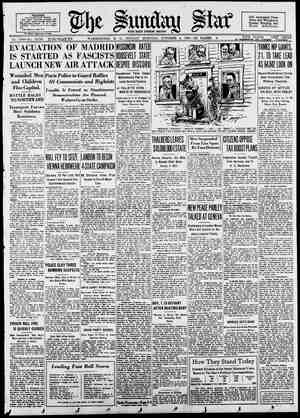Evening Star Newspaper, October 4, 1936, Page 85
You have reached the hourly page view limit. Unlock higher limit to our entire archive!
Subscribers enjoy higher page view limit, downloads, and exclusive features.
October 4, 1936 THIS WEEK f MEANIE EVeryone L0 i Magazine Section 5 y T was an eight-year-old girl who broke the Hollywood tradition that one cannot play a “mean” role on the screen and create a following. Playing the “meanie” in “Bright Eyes,” opposite America’s favorite, Shirley Temple, Jane Withers romped into the heart of the nation. Jane is now nine years old, and was born in Atlanta, Ga. She is of English, Irish, German and French descent. Her memory is such that she is several years ahead of most children in her studies. She plays the piano, ukulele and drum, and speaks Spanish and French. She has 196 dolls. If she keeps her New Year’s resolution not to bite her fingernails during 1936, her mother will give her four more. She weighs 74 pounds, has dark blue eyes and brown hair. She receives about three thousand letters a week. She might be called “a born actress.” Her mother, denied a stage career, decided that her child should have one. She was called Jane before birth. She attended a private pro- fessional school before she was three. She made her first public appearance under four, singing “Little Pal’’ at an Atlanta theater. After seeing Fifi Dorsay in a film, the little girl returned home and mimicked Miss Dorsay's singing of ‘“You’re Simply Delish” so well that her mother bought the phono- graph record. The following week she did an impersonation of Miss Dorsay over the radio. For the next two years she attended a movie each week and later impersonated the star on the air. Known as “Atlanta’s Sweetheart,”” she be- came the mascot for the Georgia Tech foot- ball team. Radio officials advised Mrs. Withers to take Jane to Hollywood. The breaking up of the home was a serious step for all. Mr. Withers was the branch manager of a rubber company. His salary was not large. It was decided that Jane and her mother should take a six months’ chance in the film city. Arriving in Hollywood, the two travelers were friendless and lonely. With letters from theater managers and radio station directors and several books of “‘press notices,” Mrs. Withers found casting offices unimpressed. For six months mother and daughter made the rounds of the studios. It was time to re- turn to Atlanta when word came from Mr. Withers to try it a while longer. Jane’s mother arranged for her to make appearances at neighborhood theaters and at SAYS MR. COBB: “I'VE YET TO KNOW A SWEETER AND MORE WHOLLY NATURAL GIRL" many benefits, hoping that her talent would be recognized. She was at last given a small part in the film, “Handle With Care.” It was the “bréak”’ they needed. Mrs. Withers wrote to her Atlanta friends to be sure to see the pic- ture. They did. Jane’s bit had been left on the cutting-room floor. Dismayed but still hopeful, the little girl appeared in a half-dozen films, among them SHE HAS 196 DOLLS — AND MAYBE, NEXT YEAR, SHE'LL HAVE 200 Little Jane Withers played a “mean’” role in the movies—and romped into the nation’s heart. An intimate sketch of this gifted youngster who is making Hollywood history by Jim TuLLy ““Cavalcade,” “Klondike” and ‘“‘Possessions.”” . Then the studio gates seemed to close. Mother and daughter returned to the round of benefits. The child was no further toward a film goal at the end of a year than she had been in Atlanta. She entertained for the Olympic Games contestants, the Oid Soldiers Home, the newsboy’s dinner, was “‘married” at the age of eight in a local theater, appeared in “‘A Doll's House” and was the winner of the Test. She played weeks in vaudeville, and ap- peared before many other organizations. During all this time she played one screen bit — with Ruth Chatterton in “A Journal of Crime.” : She next did a “Negro preacher” act at a benefit for colored men. Competing with Carole Lombard, Warren William and Con- stance Bennett, she easily “stole’” the show — to such an extent that an act was written for her in “Hollywood on Parade.” The clouds had slightly parted. Her next appearance was in a film “short” in which she satirized a presidential campaign speaker most effectively. After bits with Eddie Cantor in “Kid Millions’” and with W. C. Fields in “It’s a Gift,” she *“‘dubbed” the voices for a dozen animated cartoons in which she was heard but never seen But glory and money were no more plentiful than in Atlanta. Besides, the home was divided, It was October of 1934. Mrs. Withers de- bated long with herself. Was her child’s probable success greater than her duty to her In her many wanderings about Hollywood she had found a man who was fond of Jane — Irvin S. Cobb. She went to his home, and told him her problem. With a drawl as warm as his heart, Cobb asked if she believed in hunches. When she replied in the affirmative, he said, *“I knew you did. I*was calling you tomorrow, but you had the hunch to come here. My friend Dave Butler's casting for a new pic- ture. There’s a little girl in it that Jane can (Continved on page 73)
